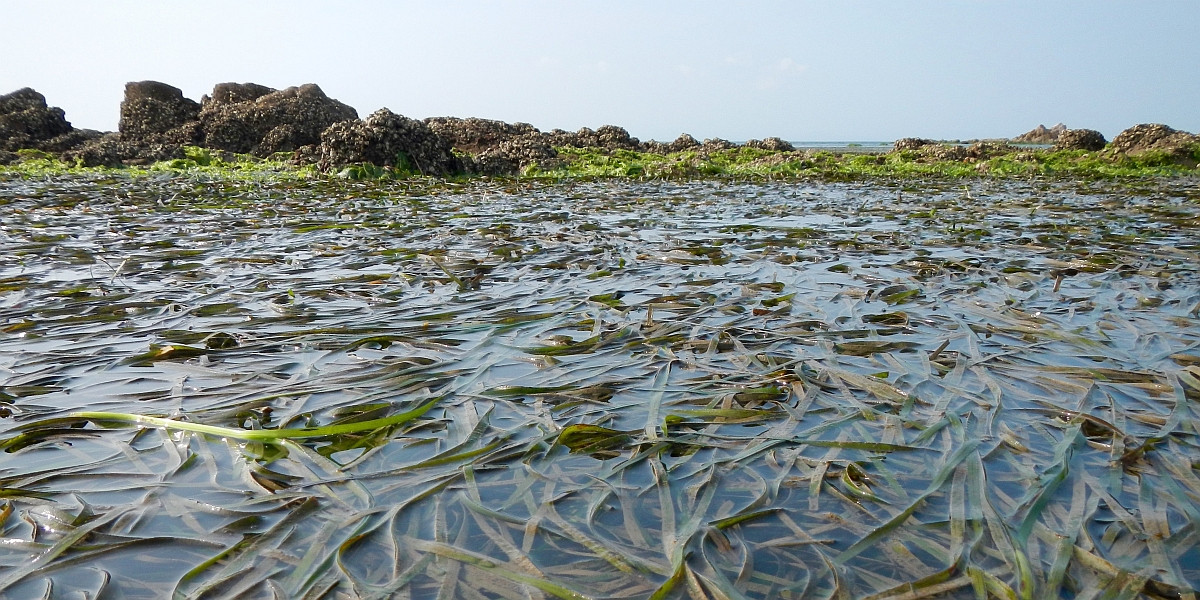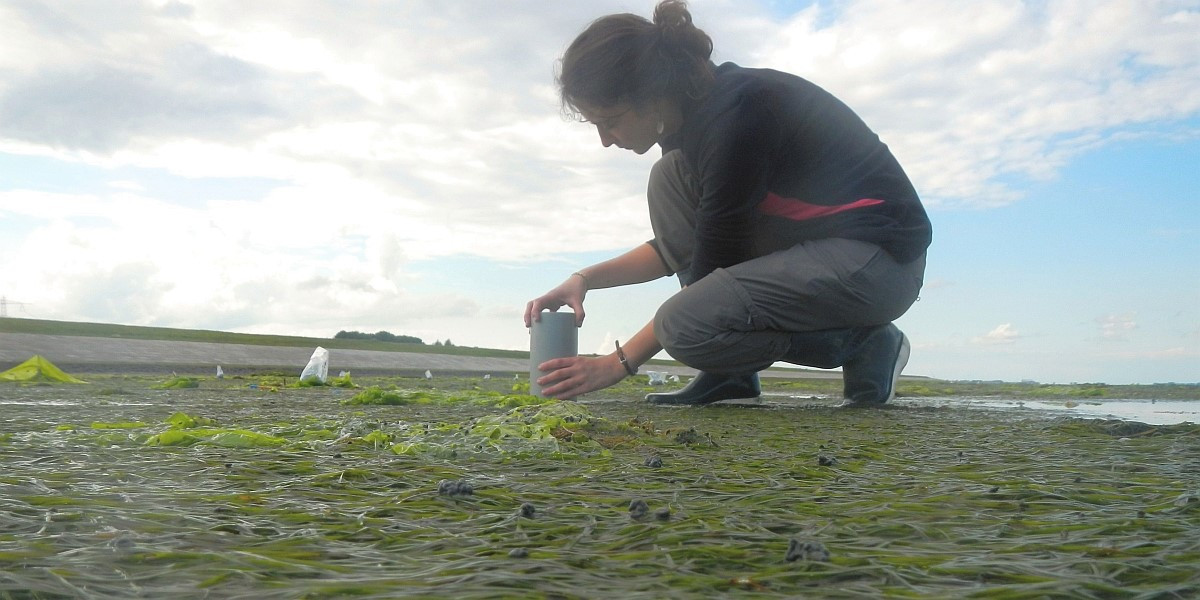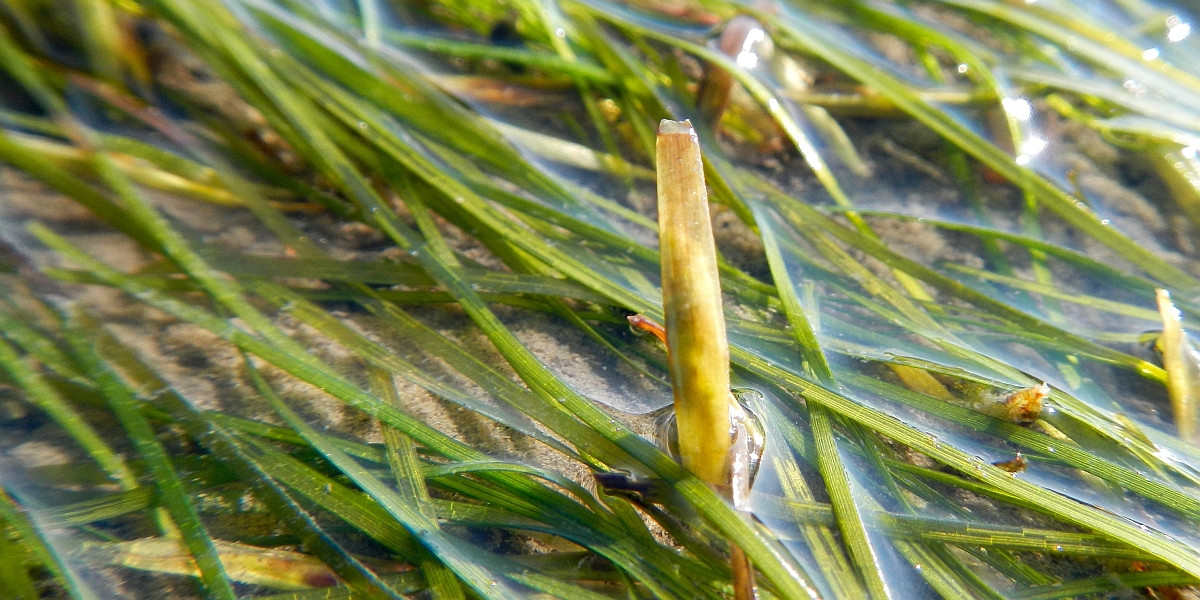Hoe zeegras omgaat met stress door bio-bouwen in zijn eigen omgeving
English translation below Dutch message
Zeegrassen zijn bloeiende planten die vooral onderwater leven, maar ook op droogvallende platen voorkomen. Van de tropen tot in Zweden vinden we in ondiepe kustgebieden zeer productieve grote zeegrasvelden, die de ruggengraat vormen van een grote rijkdom aan vissen en andere dieren. Zeegrasvelden staan echter wereldwijd onder zware druk, wat de noodzaak verhoogt om tot een beter begrip te komen van de invloed van verschillende stressfactoren die de veerkracht van zeegrasvelden kunnen beïnvloeden. Denk daarbij bijvoorbeeld aan golven en overmatige toevoer van voedingsstoffen (eutrofiëring).
Zwakte als kracht
Zeegras is in staat om zijn omgeving aan te passen, wat bijdraagt aan zijn eigen ontwikkeling en de ontwikkeling van andere organismen. Laura Soissons: “Uit mijn onderzoek blijkt dat door deze eigenschap van “biobouwen”, het zeegras de effecten van omgevings-stress kan verminderen, en zijn veerkracht kan verhogen. Ik vond bijvoorbeeld dat een bepaalde soort zeegras zijn energie kan besteden aan een snelle groei waarbij het weefsel zwakker is, of aan een langzame groei met heel stevige weefsels. Het snelgroeiende zeegras lekte meer zuurstof door zijn zwakkere wortels. Deze zuurstof ontgiftte wel het zwavel (sulfide) in de zuurstofloze bodem. Onder dergelijke omstandigheden is een snelle groei met een zwakke weefsels dus een betere keuze van de plant dan een langzamere groei met stevige weefsels.”
Timing is alles
In gematigde omgevingen groeit zeegras seizoensgebonden. Midden in de zomer, is de biomassa van de zeegrasplanten het hoogst, maar hun veerkracht het laagst. Daarom veroorzaakt een verstoring van zeegras tijdens de groeipiek de meeste blijvende schade. Het goed plannen van een mogelijke –maar soms onvermijdelijke- verstoring door de mens is dus zeer belangrijk om de risico’s voor schade aan zeegrasvelden te verminderen.
Zuid- versus Noord
Verschillende populaties van dezelfde zeegrassoorten zijn aanwezig over grote Noord-Zuid gradiënten. Langs deze gradiënten hebben populaties verschillende strategieën om te overleven. Zo is een noordelijk en seizoensgebonden groeiend zeegrasveld zeer gevoelig voor kortstondige stressgebeurtenissen aan het einde van het groeiseizoen, wanneer de koolstofreserves het hoogst zijn. Dit omdat het de zaadproductie verstoort, die dan op zijn hoogtepunt is. Bij zuidelijke zeegrasvelden speelt dit minder een rol, omdat deze ‘evergreen’ vooral op asexuele groei vertrouwt.
Laura Soissons’ promotieonderzoek werd uitgevoerd als onderdeel van de gezamenlijke NSFC-NWO overeenkomst tussen Nederland en China. Deze regeling voor onderzoek in estuariene systemen is gestart in 2011. Het project werd uitgevoerd bij het NIOZ, bij de Yantai Instituut voor kustonderzoek (YIC-CAS) in China en in heel Europa, in samenwerking met een groot aantal Europese onderzoeksinstituten.
___________________________________________________________________________________________
How seagrass copes with stress by bio-engineering its own environment
Seagrass meadows are highly productive bio-engineers, supporting ecosystems in coastal areas across the world. However, these important meadows are declining on a large scale, and the causes are mostly linked to human activities, such as water pollution. To manage seagrass meadows responsibly, suitable indicators are needed for both the health of the seagrass and its resilience to environmental stress factors. During her PhD research at NIOZ Royal Netherlands Institute for Sea Research and the Yantai Institute for Coastal Zone Research in China, Laura Soissons observed that differnt species of seagrass can reduce stress effects on their health and improvetheir resilience by modifying their own environment. She will defend her PhD thesis on the 30th of March at the Radboud University Nijmegen.
Seagrasses are marine flowering plants forming extensive and highly productive meadows in coastal areas worldwide over a large climatological gradient. As important bio-engineers that shape their own environment, they also form the backbone of an ecosystem that can only flourish in the presence of seagrass. However, seagrass meadows are threatened globally, raising the need to better understand their resilience under threat by a variety of stressors such as waves and excessive nutrient supply (eutrophication).
Turning weakness into strength
Seagrass is capable of modifying its environment for its own development and the development of other organisms. Laura Soissons: “My research shows that through this property of ecosystem engineering, seagrass can reduce the effect of a stressor, creating a shortcut to its own resilience. For instance, I found that a species of grass, spending its resources on fast growth with weaker tissues instead of slow-growth with very sturdy tissues, produced more oxygen through its weak and leaky roots. By producing and leaking oxygen into the oxygen-depleted sediment on which the grass was growing, it effectively detoxified the sulphide present underneath in the anoxic sediment. Thus, under such circumstances fast growth with weak tissues is the better choice.”
Timing is everything
In temperate environments, seagrasses grow seasonally. At the peak of growth in summer, the biomass of the plants is highest, but their resilience is lowest. Therefore, a disturbance of the plants at this moment will considerably reduce the chances of the seagrass recovering fully from an unfavourable human interference. For this reason, it is very important to consider the timing of a -sometimes unavoidable- human interference moment carefully to avoid unnecessary damage.
North versus South
Different populations of the same seagrass species are present over large North-South gradients. Along those gradients, populations have different strategies to resist stress and survive. A northern seagrass meadow will be very sensitive to short-term stress events at the end of the growing season, when the plants are filled with seeds, and their carbon reserves are highest. A southern seagrass meadow relies more on asexual growth, because seed production is lower in warm environments. This makes it very sensitive to disturbances affecting the condition of their tissues, as their seed production may be insufficient for recovery after the stressor has gone.
Laura Soissons’s PhD project was conducted as part of the NSFC-NWO joint scheme, initiated in 2011 between The Netherlands and China to study estuarine systems. The project was mainly conducted at NIOZ and at the Yantai Institute for coastal zone research (YIC-CAS) in China, with many cooperations with European marine research institutes.


